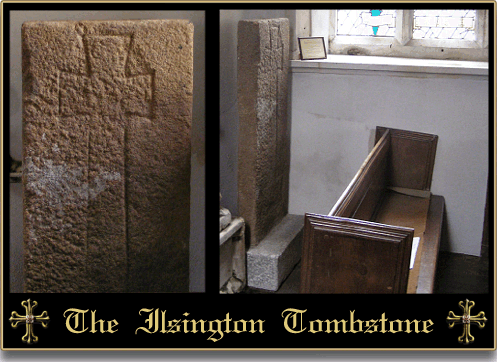
Well Ok, ‘Bridge of the Underworld’ is a bit dramatic but it sounds pretty interesting you must admit, conjures up images of dark misty caverns with a solitary bridge leading over a fetid river into a world of darkness and despair. Sadly, it’s nothing like that at all, it’s another reclamation of Ilsington’s heritage by the local folk. There is however an element of mystery attached to the story which I think to this day has not been fully explained. There are several Dartmoor tales of stones that dance, go down to rivers to drink and turn around in the socket holes but this ‘Bridge of the Underworld’ is no fancy fireside story it lies firmly in the realms of fact.
On Tuesday the 12th of December 2006 a team comprising of Dartmoor National Park Authority archaeologist and conservation workers returned a coverstone from a tomb to Ilsington parish church, nothing startling in that It was suggested at the time that the coverstone was originally removed from the central aisle of the church during repair work to the floor, which according to the DNPA was in 1883, nothing startling in that. The stone then suddenly reappeared when it was discovered serving as a bridge over a stream, several such monumental stones have been found in such a position. Afterall, when needing a stone slab for a small footbridge do you quarry and fashion one or simply recycle the nearest available material regardless from whence it came? Nothing startling in that. What is startling is that the coverstone was acting as a bridge over the Cadewell Stream near Torquay which from Ilsington is some 13 miles away. The big question is, why on earth would anybody want to lug a slab of granite which weighed just under a ton, 13 miles down the road, purely to act as a bridge over a stream? Now you can see why this page is titled ‘Bridge of the Underworld‘, a macabre story of a tombstone being taken from a church and then used in the ‘Underworld’, namely Torquay as a crossing point.
Anyway, it was in 1926 when the tombstone was re-discovered and after 43 years of exposure and misuse the slab was returned to the Torquay Museum for safe keeping. Once again a mystery, how did it become known that the granite slab belonged to Islington Church? The only markings on it are an incised cross and reportedly two letters which could be a ‘W’ and a ‘B’. So unless somebody knew who took the stone and from whence it came, surely there would not be enough evidence to know that it came from Ilsington?

The DNPA experts suggest that if the letters are ‘WB’ then this may indicate that the tomb coverstone belonged to a one-time incumbent of the church. Also giving credence to this theory is the very fact that the slab was taken from a central aisle, a place normally reserved for the burial of important members of the clergy or prestigious benefactors of the church. There have been two incumbents with such initials William Bousquyer (1438), and William Bickford (1562), and William Bettenson (1663), all contenders for the coverstone.
Back to fact, the coverstone was fixed to a granite pedestal which was made by the DNPA’s Conservation Works Team and was placed in its new resting place at 10.am on the 12th of December. Now, here’s logic, you spend time and precious funds on restoring an artefact to its rightful place, you announce the fact in a media release and then what do you do? Well, you stuff it in the far corner of the church’s north transept where over half of it is hidden by a pew and nobody can actually see it in its full glory. Why bother mounting it on a beautifully fashioned pedestal that nobody can hardly see? Why not simply lay it against the wall or dump it outside in the churchyard?
 Legendary Dartmoor The many aspects past and present of Dartmoor
Legendary Dartmoor The many aspects past and present of Dartmoor
